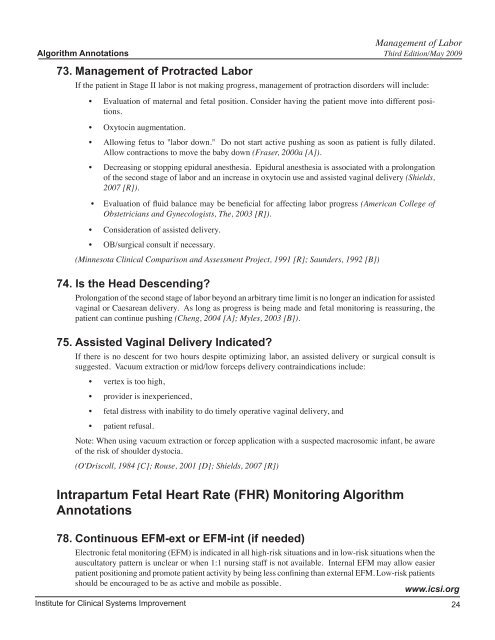Management of Labor
Management of Labor
Management of Labor
Create successful ePaper yourself
Turn your PDF publications into a flip-book with our unique Google optimized e-Paper software.
<strong>Management</strong> <strong>of</strong> <strong>Labor</strong><br />
Algorithm Annotations Third Edition/May 2009<br />
73. <strong>Management</strong> <strong>of</strong> Protracted <strong>Labor</strong><br />
If the patient in Stage II labor is not making progress, management <strong>of</strong> protraction disorders will include:<br />
• Evaluation <strong>of</strong> maternal and fetal position. Consider having the patient move into different positions.<br />
• Oxytocin augmentation.<br />
• Allowing fetus to "labor down." Do not start active pushing as soon as patient is fully dilated.<br />
Allow contractions to move the baby down (Fraser, 2000a [A]).<br />
• Decreasing or stopping epidural anesthesia. Epidural anesthesia is associated with a prolongation<br />
<strong>of</strong> the second stage <strong>of</strong> labor and an increase in oxytocin use and assisted vaginal delivery (Shields,<br />
2007 [R]).<br />
• Evaluation <strong>of</strong> fluid balance may be beneficial for affecting labor progress (American College <strong>of</strong><br />
Obstetricians and Gynecologists, The, 2003 [R]).<br />
• Consideration <strong>of</strong> assisted delivery.<br />
• OB/surgical consult if necessary.<br />
(Minnesota Clinical Comparison and Assessment Project, 1991 [R]; Saunders, 1992 [B])<br />
74. Is the Head Descending?<br />
Prolongation <strong>of</strong> the second stage <strong>of</strong> labor beyond an arbitrary time limit is no longer an indication for assisted<br />
vaginal or Caesarean delivery. As long as progress is being made and fetal monitoring is reassuring, the<br />
patient can continue pushing (Cheng, 2004 [A]; Myles, 2003 [B]).<br />
75. Assisted Vaginal Delivery Indicated?<br />
If there is no descent for two hours despite optimizing labor, an assisted delivery or surgical consult is<br />
suggested. Vacuum extraction or mid/low forceps delivery contraindications include:<br />
• vertex is too high,<br />
• provider is inexperienced,<br />
• fetal distress with inability to do timely operative vaginal delivery, and<br />
• patient refusal.<br />
Note: When using vacuum extraction or forcep application with a suspected macrosomic infant, be aware<br />
<strong>of</strong> the risk <strong>of</strong> shoulder dystocia.<br />
(O'Driscoll, 1984 [C]; Rouse, 2001 [D]; Shields, 2007 [R])<br />
Intrapartum Fetal Heart Rate (FHR) Monitoring Algorithm<br />
Annotations<br />
78. Continuous EFM-ext or EFM-int (if needed)<br />
Electronic fetal monitoring (EFM) is indicated in all high-risk situations and in low-risk situations when the<br />
auscultatory pattern is unclear or when 1:1 nursing staff is not available. Internal EFM may allow easier<br />
patient positioning and promote patient activity by being less confining than external EFM. Low-risk patients<br />
should be encouraged to be as active and mobile as possible.<br />
www.icsi.org<br />
Institute for Clinical Systems Improvement<br />
24
















